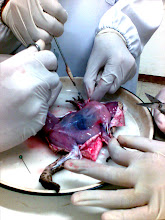


Name: The Biologist and the Scientist
From: Davao City, Philippines, Philippines
About me: We are the students of the most prestigious university, that is, the University of the Philippines - Mindanao. We are the the future Biologists, Marine Biologists, Scientist, Doctors - you name it. And most of all, we opt to receive the Nobel Prize in the near future! XD
Dec. 12, 2008 -- It was a dying on a scale never seen before or since on Earth. The slaughter was everywhere; the fertile ocean and balmy supercontinent Pangea were transformed into killing fields, littered with the bodies of ancient animals. By the time the dust had settled on the Permian-Triassic mass extinction 250 million years ago, 90 percent of life on the planet had been snuffed out.
 Now a new theory suggests the catastrophe was set in motion 15 million years earlier, deep in the Earth. On the edge of the molten outer core, a plume of super-hot material began rising through the mantle, upsetting convection in the core and throwing the planet's magnetic field into disarray.
Now a new theory suggests the catastrophe was set in motion 15 million years earlier, deep in the Earth. On the edge of the molten outer core, a plume of super-hot material began rising through the mantle, upsetting convection in the core and throwing the planet's magnetic field into disarray.
The weakening of Earth's magnetic field exposed the surface to a shower of cosmic radiation, says Yukio Isozaki of the University of Tokyo. He believes the radiation broke nitrogen in the atmosphere into ions that acted as seeds for clouds enshrouding the planet.
"This would've caused severe cooling and a drop in sea level" as the cool temperatures allowed massive ice sheets to accumulate on the continents, Isozaki said. "If you check the rock record at that time, tropical coral reefs die first. Then you start to see fauna from mid latitudes move into the tropics. It all points to cooling."
The superplume disrupted the magnetic field and put a strain on creatures living on the surface, but it was only the beginning. Five million years later it reached the surface, Isozaki said, and the hot material punched through the crust, erupting as three successive supervolcanoes.
Today the remnants of those volcanoes are scattered through India, China and Norway. On their own they were too small to do much harm, but together Isozaki thinks they cooled the climate even further, launching an extinction as bad as the one that would kill the dinosaurs 185 million years later.
Then, 10 million years later, the Permian-Triassic extinction struck.
"The effects of the superplume were just the first punch of extinction," Isozaki said. "Then came the knockout punch, the Permian-Triassic extinction."
Isozaki thinks both "punches" were caused by the same superplume. Ten million years after the smaller volcanoes blew their tops, a much larger volcano, the Siberian Traps, erupted, launching the worst killing in the planet's history.
Gregory Retallack of the University of Oregon agrees that the late Permian round of extinction was bad -- as much as 67 percent of species were eradicated. But he doesn't think the two events are related. In the 10 million years after the first punch in the late Permian, he said, life recovered.
"The late Permian looks good all over the world," Retallack said. "You've got corals, healthy marine communities, and lots of fossil flora on land."
There's no questioning the severity of the Permian-Triassic crisis -- "We almost lost it there," Retallack said -- but whether the two can be traced a single mantle superplume, or they were unrelated, remains a mystery for now.